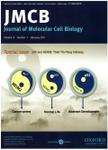SNORD126 promotes HCC and CRC cell growth by activating the PI3K-AKT pathway through FGFR2
SNORD126 promotes HCC and CRC cell growth by activating the PI3K-AKT pathway through FGFR2作者机构:State Key Laboratory of Cell Biology Institute of Biochemistry and Cell Biology Shanghai Institutes for Biological Sciences Chinese Academy of Sciences Shanghai 200031 China Xinyuan Institute of Medicine and Biotechnology Zhejiang Sci-Tech University Hangzhou Zhejiang 310018 China Hepatic Surgery Center Tongji Hospital Tongji Medical College Huazhong University of Science and Technology Wuhan 430030 China
出 版 物:《Journal of Molecular Cell Biology》 (分子细胞生物学报(英文版))
年 卷 期:2017年第9卷第3期
页 面:243-255页
核心收录:
学科分类:1305[艺术学-设计学(可授艺术学、工学学位)] 0710[理学-生物学] 13[艺术学] 071010[理学-生物化学与分子生物学] 081704[工学-应用化学] 07[理学] 08[工学] 0817[工学-化学工程与技术]
基 金:国家自然科学基金 上海市自然科学基金 Youth Innovation Promotion Association, Chinese Academy of Sciences Shanghai Municipal Science and Technology Commission Fund
主 题:small nucleolar RNA HCC CRC FGFR2 PI3K-AKT
摘 要:Small nucleolar RNA (snoRNA) dysfunctions have been associated with cancer development. SNORD126 is an orphan C/D box snoRNA that is encoded within introns 5-6 of its host gene, cyclin Bl-interacting protein 1 (CCNBIIP1). The cancer-associated molecular mechanisms triggered by SNORD126 are not fully understood. Here, we demonstrate that SNORD126 is highly expressed in hepatoceUular carcinoma (HCC) and colorectal cancer (CRC) patient samples. SNORD126 increased Huh-7 and SW480 cell growth and tumorigenicity in nude mice. Knockdown of SNORD126 inhibited HepG2 and LS174T cell growth. We veri- fied that SNORD126 was not processed into small RNAs with miRNA activity. Moreover, SNORD126 did not show a significant expression correlation with CCNBIlP1 in HCC samples or regulate CCNBIlP1 expression. Our gene expression profile analysis indicated that SNORD126-upregulated genes frequently mapped to the PI3K-AKT pathway. SNORD126 overexpression increased the levels of phosphorylated AKT, GSK-3p, and p7056K and elevated fibroblast growth factor receptor 2 (FGFR2) expression. siRNA-mediated knockdown or AZD4547-mediated inactivation of FGFR2 in SNORD126-overexpressing Huh-7 cells inhibited AKT phosphorylation and suppressed cell growth. These findings indicate an oncogenic role for SNORD126 in cancer and suggest its potential as a therapeutic target.



